Using a Groundwater Adjusted Water Balance Approach and Copulas to Evaluate Spatial Patterns and Dependence Structures in Remote Sensing Derived Evapotranspiration Products
Abstract
1. Introduction
- (1)
- to improve the surface WB ET approach through add of GW-net data in the ET calculation;
- (2)
- to evaluate the spatial patterns in three MODIS-based RS ET products using the improved WB ET approach;
- (3)
- to estimate the dependence structures and similarity ranking amongst the ET products using Copula and PCA approaches.
2. Study Area Characterization
3. Data and Methods
3.1. Data
3.1.1. Water Balance ET Approaches
3.1.2. Remote-Sensing ET Models
3.2. Methods
- Catchment water balance ET estimates from standard and modified approaches using groundwater net;
- Estimation of ET dependence structures using empirical Copula approach; and
- Assessment of ET similarity using a PCA analysis.
3.2.1. Catchment WB ET Estimates
3.2.2. Empirical Copula-Based ET Dependence Structures Analysis
3.2.3. PCA-Based Similarity Assessment of ET Products
4. Results and Discussion
4.1. Remote-Sensing Derived Evapotranspiration
4.2. Catchment Water Balance ET
4.2.1. Spatial Comparisons of WB/RS ET Products
4.3. Dependence Structures of ET Products: Copula-Based Analysis
4.4. Similarity Assessment of ET Products: PCA-Based Analysis
4.5. ET Uncertainties
5. Conclusions
- The ET-WBQ spatial patterns indicated a significant inconsistency over Denmark, with an energy-limited environment; however, it was improved especially for smaller catchments, when GW-net data was included in the ET-WBQ-GW estimate. Nevertheless, there is still challenges in applying the WB ET approach to small regions.
- The TSEB, MODIS16, and PML_V2 ET estimates varied largely compared to ET-WBQ-GW; as a result, a large discrepancy was observed amongst the ET products at the national scale of Denmark. However, many catchments had ∆ET < ±150 mm/year. Regional analysis also indicated that RS ET uncertainties decrease with increasing catchment size.
- The Copula analysis captured a nonlinear structure amongst the ET products with multiple densities (either in lower or upper ranks), showing a complex relationship between not only the RS ET datasets, but also between ET-WBQ-GW and MODIS-based ET products. The ET-WBQ-GW and MODIS16 ET showed a closer spatial pattern as identified by PCA analysis, indicating a good potential for future applications over the study area.
- Finally, it is recommended that for WB ET calculation, future studies should incorporate GW-net from surrogate hydrological models if available. In addition, Copula approach can be considered in other catchments worldwide for estimating true relationships amongst water balance (or energy balance) components in addition to traditional statistical analyses.
Author Contributions
Funding
Data Availability Statement
Acknowledgments
Conflicts of Interest
Appendix A Water Balance Visualization
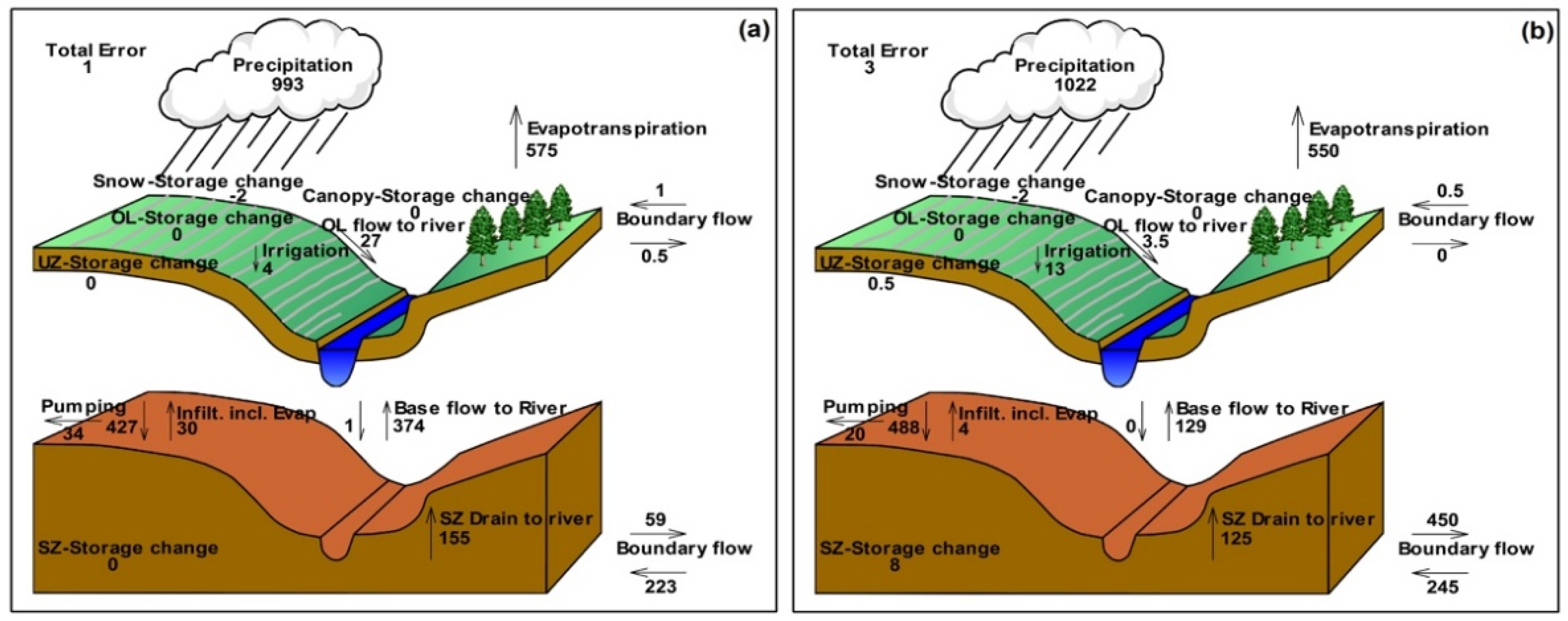
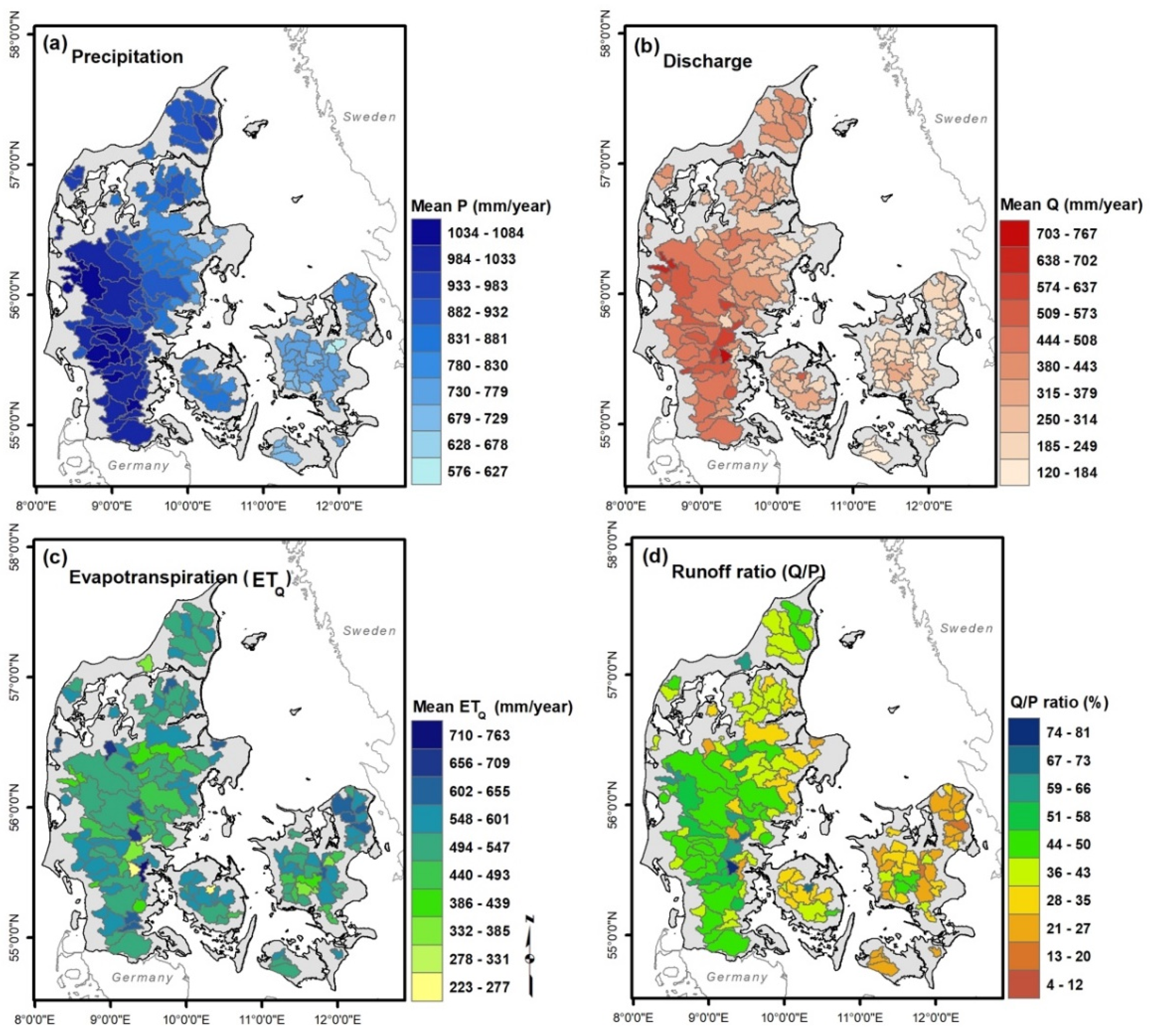
Appendix B Copula-Based Dependence Structures Analysis
Appendix B.1. The Grid-Based RS ET Dependence Structures
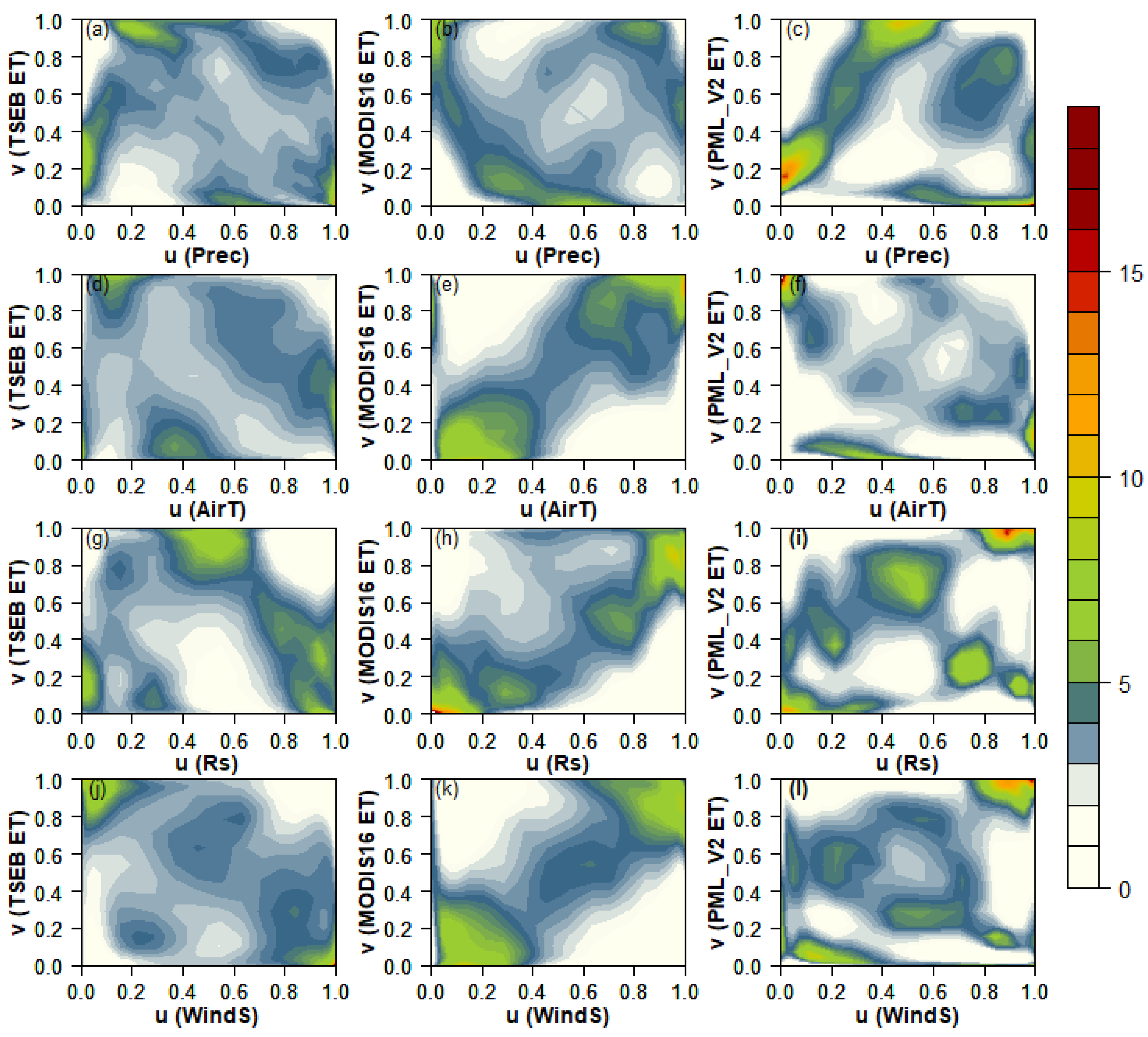
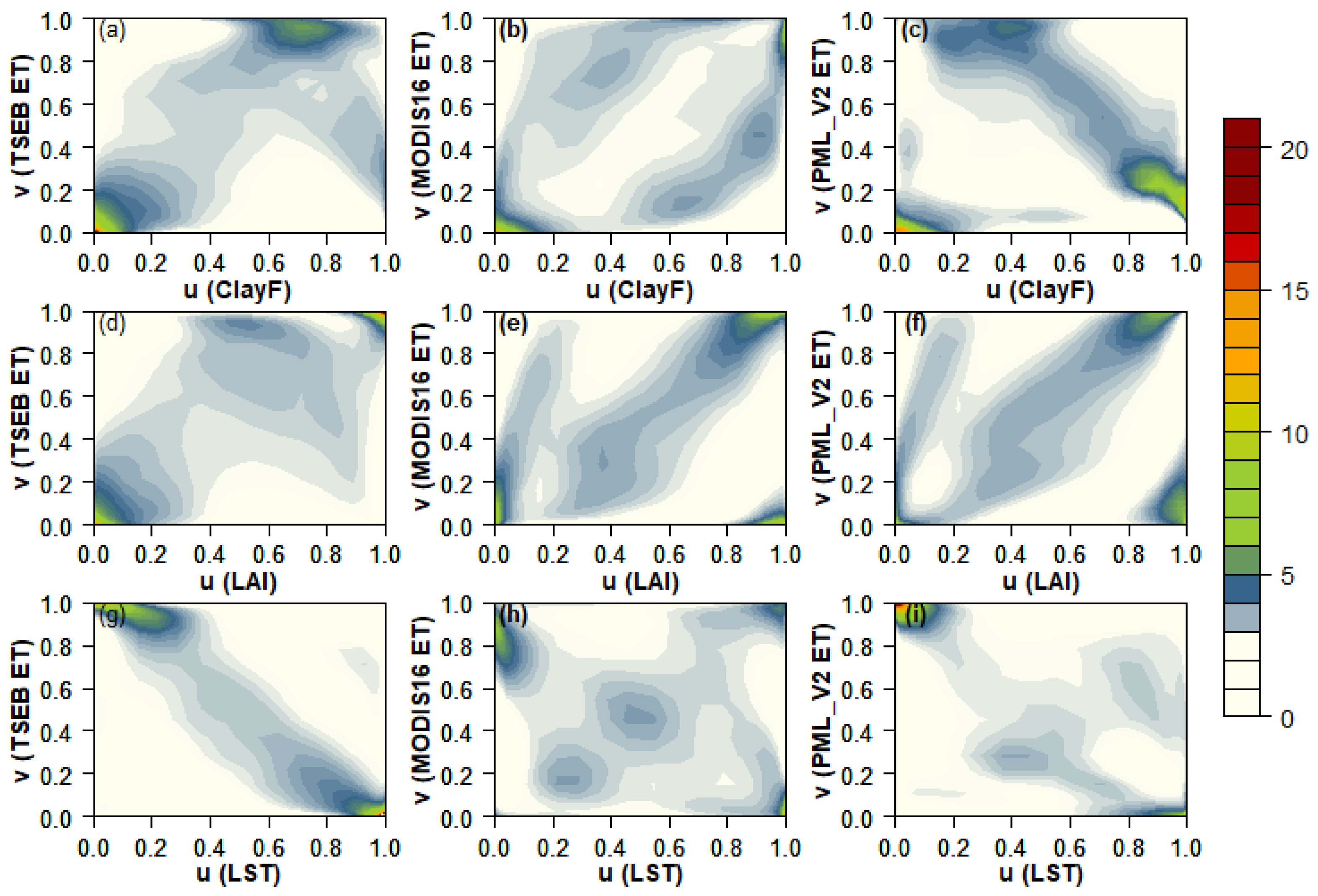
Appendix B.2. The Catchment-Based WB ET Dependence Structures
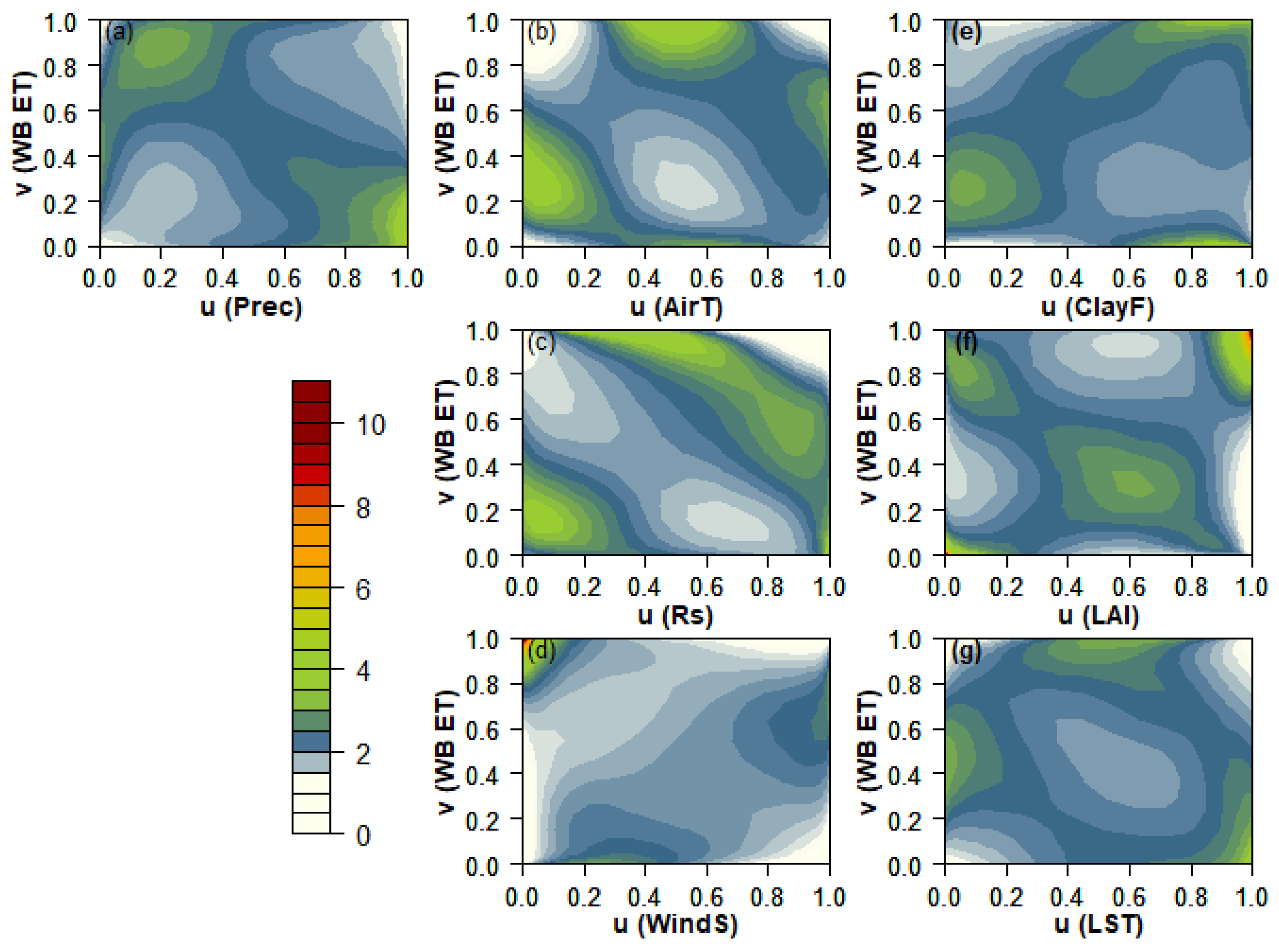
References
- Chahine, M.T. The hydrological cycle and its influence on climate. Nature 1992, 359, 373–380. [Google Scholar] [CrossRef]
- Oki, T.; Kanae, S. Global hydrological cycles and world water resources. Science 2006, 313, 1068–1072. [Google Scholar] [CrossRef]
- Sheffield, J.; Wood, E.F.; Munoz-Arriola, F. Long-term regional estimates of evapotranspiration for Mexico based on downscaled ISCCP data. J. Hydrometeorol. 2010, 11, 253–275. [Google Scholar] [CrossRef]
- Samain, B.; Simons, G.W.H.; Voogt, M.P.; Defloor, W.; Bink, N.J.; Pauwels, V.R.N. Consistency between hydrological model, large aperture scintillometer and remote sensing based evapotranspiration estimates for a heterogeneous catchment. Hydrol. Earth Syst. Sci. 2012, 16, 2095–2107. Available online: www.hydrol-earth-syst-sci.net/16/2095/2012/ (accessed on 1 July 2020). [CrossRef]
- Zhang, B.; Xia, Y.; Long, B.; Hobbins, M.; Zhao, X.; Hain, C.; Li, Y.; Anderson, M.C. Evaluation and comparison of multiple evapotranspiration data models over the contiguous United States: Implications for the next phase of NLDAS (NLDAS-Testbed) development. Agric. For. Meteorol. 2019, 280, 107810. [Google Scholar] [CrossRef]
- Xu, C.Y.; Singh, V.P. Evaluation of three complementary relationship evapotranspiration models by water balance approach to estimate actual regional evapotranspiration in different climatic regions. J. Hydrol. 2005, 308, 105–121. [Google Scholar] [CrossRef]
- Gao, Y.; Long, D. Intercomparison of remote sensing-based models for estimation of evapotranspiration and accuracy assessment based on SWAT. Hydrol. Process. 2008, 22, 4850–4869. [Google Scholar] [CrossRef]
- Peng, J.; Loew, A.; Chen, X.; Ma, Y.; Su, Z. Comparison of satellite-based evapotranspiration estimates over the Tibetan Plateau. Hydrol. Earth Syst. Sci. 2016, 20, 3167–3182. Available online: www.hydrol-earth-syst-sci.net/20/3167/2016/ (accessed on 1 July 2020). [CrossRef]
- Baldocchi, D.; Falge, E.; Gu, L.; Olson, R.; Hollinger, D.; Running, S.W.; Anthoni, P.; Bernhofer, C.; Davis, K.; Evans, R.; et al. FLUXNET: A new tool to study the temporal and spatial variability of ecosystem-scale carbon dioxide, water vapor, and energy flux densities. Bull. Am. Meteorol. Soc. 2001, 82, 2415–2434. [Google Scholar] [CrossRef]
- Wilson, K.B.; Hanson, P.J.; Mulholland, P.J.; Baldocchi, D.D.; Wullschleger, S.D. A comparison of methods for determining forest evapotranspiration and its components: Sap-flow, soil water budget, eddy covariance and catchment water balance. Agric. For. Meteorol. 2001, 106, 153–168. [Google Scholar] [CrossRef]
- Mauder, M.; Foken, T. Impact of post-field data processing on eddy covariance flux estimates and energy balance closure. Meteorol. Z. 2006, 15, 597–609. [Google Scholar] [CrossRef]
- Soltani, M.; Mauder, M.; Laux, P.; Kunstmann, H. Turbulent flux variability and energy balance closure in the TERENO prealpine observatory: A hydrometeorological data analysis. Theor. Appl. Climatol. 2017, 133, 937–956. [Google Scholar] [CrossRef]
- Ringgaard, R.; Herbst, M.; Friborg, T.; Schelde, K.; Thomsen, A.; Søgaard, H. Energy fluxes above three disparate surfaces in a temperate mesoscale coastal catchment. Vadose Zone J. 2011, 10, 54–66. [Google Scholar] [CrossRef][Green Version]
- Mendiguren, G.; Koch, K.; Stisen, S. Spatial pattern evaluation of a calibrated national hydrological model—A remote-sensing-based diagnostic approach. Hydrol. Earth Syst. Sci. 2017, 21, 5987–6005. [Google Scholar] [CrossRef]
- Milly, P.C.D.; Dunne, K.A. Trends in evaporation and surface cooling in the Mississippi River basin. Geophys. Res. Lett. 2001, 28, 1219–1222. [Google Scholar] [CrossRef]
- Walter, M.T.; Wilks, D.S.; Parlange, J.Y.; Schneider, R.L. Increasing evapotranspiration from the conterminous United States. J. Hydrometeorol. 2004, 5, 405–408. [Google Scholar] [CrossRef]
- Conradt, T.; Wechsung, F.; Bronstert, A. Three perceptions of the evapotranspiration landscape: Comparing spatial patterns from a distributed hydrological model, remotely sensed surface temperatures, and sub-basin water balances. Hydrol. Earth Syst. Sci. 2013, 17, 2947–2966. Available online: www.hydrol-earth-syst-sci.net/17/2947/2013/ (accessed on 10 April 2020). [CrossRef]
- Zeng, Z.; Wang, T.; Zhou, F.; Ciais, P.; Mao, J.; Shi, X.; Piao, S. A worldwide analysis of spatiotemporal changes in water balance-based evapotranspiration from 1982 to 2009. J. Geophys. Res. Atmos. 2014, 119, 1186–1202. [Google Scholar] [CrossRef]
- Han, E.; Crow, W.T.; Hain, C.R.; Anderson, M.C. On the use of a water balance to evaluate interannual terrestrial ET variability. J. Hydrometeorol. 2015, 16, 1102–1108. [Google Scholar] [CrossRef]
- Wang, S.; Huang, J.; Yang, D.; Pavlic, G.; Li, J. Long-term water budget imbalances and error sources for cold region drainage basins. Hydrol. Process. 2015, 29, 2125–2136. [Google Scholar] [CrossRef]
- Liu, W.; Wang, L.; Zhou, J.; Li, Y.; Sun, F.; Fu, G.; Li, X.; Sang, Y.F. A worldwide evaluation of basin-scale evapotranspiration estimates against the water balance method. J. Hydrol. 2016, 538, 82–95. [Google Scholar] [CrossRef]
- Mao, Y.; Wang, K. Comparison of evapotranspiration estimates based on the surface water balance, modified Penman-Monteith model, and reanalysis data sets for continental China. J. Geophys. Res. Atmos. 2017, 122, 3228–3244. [Google Scholar] [CrossRef]
- Dai, A.; Qian, T.; Trenberth, K.E.; Milliman, J.D. Changes in continental freshwater discharge from 1948 to 2004. J. Clim. 2009, 22, 2773–2792. [Google Scholar] [CrossRef]
- Wang, S.; McKenney, D.W.; Shang, J.; Li, J. A national-scale assessment of long-term water budget closures for Canada’s watersheds. J. Geophys. Res. Atmos. 2014, 119, 8712–8725. [Google Scholar] [CrossRef]
- Bouaziz, L.; Weerts, A.; Schellekens, J.; Sprokkereef, E.; Stam, J.; Savenije, H.; Hrachowitz, M. Redressing the balance: Quantifying net intercatchment groundwater flows. Hydrol. Earth Syst. Sci. 2018, 22, 6415–6434. [Google Scholar] [CrossRef]
- Danapour, M.; Højberg, A.L.; Jensen, K.H.; Stisen, S. Assessment of regional inter-basin groundwater flow using both simple and highly parameterized optimization schemes. Hydrogeol. J. 2019, 27, 1929–1947. [Google Scholar] [CrossRef]
- Genereux, D.P.; Jordan, M.T.; Carbonell, D. A paired-watershed budget study to quantify interbasin groundwater flow in a lowland rain forest, Costa Rica. Water Resour. Res. 2005, 41, W04011. [Google Scholar] [CrossRef]
- Frisbee, M.D.; Tysor, E.H.; Stewart-Maddox, N.S.; Tsinnajinnie, L.M.; Wilson, J.L.; Granger, D.E.; Newman, B.D. Is there a geomorphic expression of interbasin groundwater flow in watersheds? Interactions between interbasin groundwater flow, springs, streams, and geomorphology. Geophys. Res. Lett. 2016, 43, 1158–1165. [Google Scholar] [CrossRef]
- Friedl, M.A. Relationships among remotely sensed data, surface energy balance, and area-averaged fluxes over partially vegetated land surfaces. J. Appl. Meteorol. 1996, 35, 2091–2103. [Google Scholar] [CrossRef]
- Su, Z. The Surface Energy Balance System (SEBS) for estimation of turbulent heat fluxes. Hydrol. Earth Syst. Sci. 2002, 6, 85–100. [Google Scholar] [CrossRef]
- Wang, S.; Trishchenko, A.P.; Khlopenkov, K.V.; Davidson, A. Comparison of International Panel on Climate Change Fourth Assessment Report climate model simulations of surface albedo with satellite products over northern latitudes. J. Geophys. Res. 2006, 111, D21108. [Google Scholar] [CrossRef]
- Gowda, P.H.; Chávez, J.L.; Colaizzi, P.; Tolk, J. Remote sensing based energy balance algorithms for mapping ET: Current status and future challenges. Trans. ASABE 2007, 55, 1639–1644. [Google Scholar] [CrossRef]
- Zhang, Y.; Peña-Arancibia, J.; McVicar, T.; Chiew, F.H.S.; Vaze, J.; Liu, C.; Lu, X.; Zheng, H.; Wang, Y.; Liu, Y.Y.; et al. Multi-decadal trends in global terrestrial evapotranspiration and its components. Sci. Rep. 2016, 6, 19124. [Google Scholar] [CrossRef]
- Senay, G.B.; Leake, S.; Nagler, P.L.; Artan, G.; Dickinson, J.; Cordova, J.T.; Glenn, E.P. Estimating basin scale evapotranspiration (ET) by water balance and remote sensing methods. Hydrol. Process. 2011, 25, 4037–4049. [Google Scholar] [CrossRef]
- Allen, R.G.; Pereira, L.S.; Howell, T.A.; Jensen, M.E. Evapotranspiration information reporting: I. Factors governing measurement accuracy. Agric. Water Manag. 2011, 98, 899–920. [Google Scholar] [CrossRef]
- Stisen, S.; Sandholt, I.; Nørgaard, A.; Fensholt, R.; Høgh Jensen, K. Combining the triangle method with thermal inertia to estimate regional evapotranspiration—Applied to MSG-SEVIRI data in the Senegal River basin. Remote Sens. Environ. 2008, 112, 1242–1255. [Google Scholar] [CrossRef]
- Anderson, M.C.; Kustas, W.P.; Norman, J.M.; Hain, C.R.; Mecikalski, J.R.; Schultz, L.; González-Dugo, M.P.; Cammalleri, C.; d’Urso, G.; Pimstein, A.; et al. Mapping daily evapotranspiration at field to continental scales using geostationary and polar orbiting satellite imagery. Hydrol. Earth Syst. Sci. 2011, 15, 223. Available online: www.hydrol-earth-syst-sci.net/15/223/2011/ (accessed on 20 March 2020). [CrossRef]
- Guerschman, J.P.; Van Dijk, A.I.; Mattersdorf, G.; Beringer, J.; Hutley, L.B.; Leuning, R.; Pipunic, R.C.; Sherman, B.S. Scaling of potential evapotranspiration with MODIS data reproduces flux observations and catchment water balance observations across Australia. J. Hydrol. 2009, 369, 107–119. [Google Scholar] [CrossRef]
- Vinukollu, R.K.; Wood, E.F.; Ferguson, C.R.; Fisher, J.B. Global estimates of evapotranspiration for climate studies using multi-sensor remote sensing data: Evaluation of three process-based approaches. Remote Sens. Environ. 2011, 115, 801–823. [Google Scholar] [CrossRef]
- Mu, Q.; Zhao, M.; Running, S.W. Improvements to a MODIS global terrestrial evapotranspiration algorithm. Remote Sens. Environ. 2011, 115, 1781–1800. [Google Scholar] [CrossRef]
- Senay, G.B.; Bohms, S.; Singh, R.K.; Gowda, P.H.; Velpuri, N.M.; Alemu, H.; Verdin, J.P. Operational evapotranspiration mapping using remote sensing and weather datasets: A new parameterization for the SSEB approach. J. Am. Water Resour. Assoc. 2013, 49, 577–591. [Google Scholar] [CrossRef]
- Calsaverini, R.S.; Vicente, R. An information-theoretic approach to statistical dependence: Copula information. Europhys. Lett. 2009, 88, 3–12. [Google Scholar] [CrossRef]
- Bárdossy, A.; Pegram, G. Multiscale spatial recorrelation of RCM precipitation to produce unbiased climate change scenarios over large areas and small. Water Resour. Res. 2012, 48, 9502. [Google Scholar] [CrossRef]
- Soltani, M.; Laux, P.; Mauder, M.; Kunstmann, H. Spatiotemporal variability and empirical Copula-based dependence structure of modelled and observed coupled water and energy fluxes. Hydrol. Res. 2018, 49, 1396–1416. [Google Scholar] [CrossRef]
- Bárdossy, A. Copula-based statistical models for groundwater quality parameters. Water Resour. Res. 2006, 42, W11416.1–W11416.12. [Google Scholar]
- Sugimoto, T.; Bárdossy, A.; Pegram, G.S.; Cullmann, J. Investigation of hydrological time series using copulas for detecting catchment characteristics and anthropogenic impacts. Hydrol. Earth Syst. Sci. 2016, 20, 2705–2720. [Google Scholar] [CrossRef]
- Li, T.; Guo, S.; Liu, Z.; Xiong, L.; Yin, J. Bivariate design flood quantile selection using copulas. Hydrol. Res. 2016, 48, 997–1013. [Google Scholar] [CrossRef]
- Balistrocchi, M.; Bacchi, B. Derivation of flood frequency curves through a bivariate rainfall distribution based on copula functions: Application to an urban catchment in northern Italy’s climate. Hydrol. Res. 2017, 48, 749–762. [Google Scholar] [CrossRef]
- Laux, P.; Wagner, S.; Wagner, A.; Jacobeit, J.; Bárdossy, A.; Kunstmann, H. Modelling daily precipitation features in the Volta Basin of West Africa. Int. J. Climatol. 2009, 29, 937–954. [Google Scholar] [CrossRef]
- Zhang, Q.; Li, J.F.; Singh, V.P.; Xu, C.Y. Copula-based spatio-temporal patterns of precipitation extremes in China. Int. J. Climatol. 2013, 33, 1140–1152. [Google Scholar] [CrossRef]
- Mao, G.; Vogl, S.; Laux, P.; Wagner, S.; Kunstmann, H. Stochastic bias correction of dynamically downscaled precipitation fields for Germany through Copula-based integration of gridded observation data. Hydrol. Earth Syst. Sci. 2015, 19, 1787–1806. Available online: www.hydrol-earth-syst-sci.net/19/1787/2015/ (accessed on 1 July 2020). [CrossRef]
- Laux, P.; Vogl, S.; Qiu, W.; Knoche, H.R.; Kunstmann, H. Copula-based statistical refinement of precipitation in RCM simulations over complex terrain. Hydrol. Earth Syst. Sci. 2011, 15, 2401–2419. Available online: www.hydrol-earth-syst-sci.net/15/2401/2011/ (accessed on 20 May 2020). [CrossRef]
- Schneider, R.; Henriksen, H.J.; Stisen, S. A Robust Objective Function for Calibration of Groundwater Models in Light of Deficiencies of Model Structure and Observations. Available online: https://hess.copernicus.org/preprints/hess-2019-685/ (accessed on 20 May 2020).
- Mao, Y.; Wang, K.; Liu, X.; Liu, C. Water storage in reservoirs built from 1997 to 2014 significantly altered the calculated evapotranspiration trends over China. J. Geophys. Res. Atmos. 2016, 121, 10097–10112. [Google Scholar] [CrossRef]
- Velpuri, N.M.; Senay, G.B.; Singh, R.K.; Bohms, S.; Verdin, J.P. A comprehensive evaluation of two MODIS evapotranspiration products over the conterminous United States: Using point and gridded FLUXNET and water balance ET. Remote Sens. Environ. 2013, 139, 35–49. [Google Scholar] [CrossRef]
- Zhang, Y.; Kong, D.; Gan, R.; Chiew, F.H.S.; McVicar, T.R.; Zhang, Q.; Yang, Y. Coupled estimation of 500m and 8-day resolution global evapotranspiration and gross primary production in 2002–2017. Remote Sens. Environ. 2019, 222, 165–182. [Google Scholar] [CrossRef]
- Norman, J.M.; Kustas, W.P.; Humes, K.S. Source approach for estimating soil and vegetation energy fluxes in observations of directional radiometric surface temperature. Agric. For. Meteorol. 1995, 77, 263–293. [Google Scholar] [CrossRef]
- Vejen, F.; Vilic, K.; Jensen, H. Korrigeret Nedbør 1989–2010, 2011–2012 and 2013, DMI Technical Report 14-13; Technical Report; Danish Meteorological Institute: Copenhagen, Denmark, 2014. [Google Scholar]
- Miralles, D.G.; Holmes, T.R.H.; De Jeu, R.A.M.; Gash, J.H.; Meesters, A.G.C.A.; Dolman, A.J. Global land-surface evaporation estimated from satellite-based observations. Hydrol. Earth Syst. Sci. 2011, 15, 453–469. Available online: www.hydrol-earth-syst-sci.net/15/453/2011/ (accessed on 1 April 2020). [CrossRef]
- Ghilain, N.; Arboleda, A.; Gellens-Meulenberghs, F. Evapotranspiration modelling at large scale using near-real time MSG SEVIRI derived data. Hydrol. Earth Syst. Sci. 2011, 15, 771–786. Available online: www.hydrol-earth-syst-sci.net/15/771/2011/ (accessed on 25 September 2020). [CrossRef]
- Mu, Q.; Heinsch, F.A.; Zhao, M.; Running, S.W. Development of a global evapotranspiration algorithm based on MODIS and global meteorology data. Remote Sens. Environ. 2007, 111, 519–536. [Google Scholar] [CrossRef]
- Monteith, J.L. Evaporation and the environment. Symp. Soc. Exp. Biol. 1965, 19, 205–233. [Google Scholar]
- Kalma, J.D.; McVicar, R.; McCabe, F. Estimating land surface evaporation: A review of methods using remotely sensed surface temperature data. Surv. Geophys. 2008, 29, 421–469. [Google Scholar] [CrossRef]
- Henriksen, H.J.; Troldborg, L.; Nyegaard, P.; Sonnenborg, T.O.; Refsgaard, J.C.; Madsen, B. Methodology for construction, calibration and validation of a national hydrological model for Denmark. J. Hydrol. 2003, 280, 52–71. [Google Scholar] [CrossRef]
- Stisen, S.; Højberg, A.L.; Troldborg, L.; Refsgaard, J.C.; Christensen, B.S.B.; Olsen, M.; Henriksen, H.J. On the importance of appropriate precipitation gauge catch correction for hydrological modelling at mid to high latitudes. Hydrol. Earth Syst. Sci. 2012, 16, 4157–4176. Available online: www.hydrol-earth-syst-sci.net/16/4157/2012/ (accessed on 1 February 2020). [CrossRef]
- Højberg, A.L.; Troldborg, L.; Stisen, S.; Christensen, B.B.S.; Henriksen, H.J. Stakeholder driven update and improvement of a national water resources model. Environ. Model. Softw. 2013, 40, 202–213. [Google Scholar] [CrossRef]
- Abbott, M.B.; Bathurst, J.C.; Cunge, J.A.; O’Connell, P.E.; Rasmussen, J. An introduction to the European Hydrological System —Systeme Hydrologique Europeen, “SHE”, 1: History and philosophy of a physically based, distributed modelling system. J. Hydrol. 1986, 87, 45–59. [Google Scholar] [CrossRef]
- Graham, D.N.; Butts, M.B. Flexible, integrated watershed modelling with MIKE SHE. In Watershed Models; Taylor and Francis Group: Boca Raton, FL, USA, 2005; pp. 245–272. [Google Scholar]
- Stisen, S.; McCabe, M.F.; Refsgaard, J.C.; Lerer, S.; Butts, M.B. Model parameter analysis using remotely sensed pattern information in a multi-constraint framework. J. Hydrol. 2011, 409, 337–349. [Google Scholar] [CrossRef]
- Gupta, H.V.; Kling, H.; Yilmaz, K.K.; Martinez, G.F. Decomposition of the mean squared error and NSE performance criteria: Implications for improving hydrological modelling. J. Hydrol. 2009, 377, 80–91. [Google Scholar] [CrossRef]
- Stisen, S.; Ondracek, M.; Troldborg, L.; Schneider, R.; Jon van Til, M. National Vandressource Model Modelopstilling og Kalibrering af DK-Model 2019 (In Danish). Geological Survey of Denmark and Greenland—Report. 2019. Available online: http://dk.vandmodel.dk/media/21560/geusrapport2019_31_dkmodel2019_web-1.pdf (accessed on 1 February 2020).
- Sklar, A. Fonctions de Repartition á n Dimensions et Leurs Marges; Publications de l’Institut de statistique de l’Université de Paris: Paris, France, 1959; Volume 8, pp. 229–231. [Google Scholar]
- Salvadori, G.; Michele, C.D.; Kottegoda, N.; Rosso, R. Extremes in Nature: An Approach Using Copulas. In Water Science and Technology Library; Springer: Berlin, Germany, 2007; Volume 56. [Google Scholar]
- Serinaldi, F. A multisite daily rainfall generator driven by bivariate copula-based mixed distrbutions. J. Geophys. Res. 2009, 114, D10103. [Google Scholar] [CrossRef]
- Nelsen, R. An Introduction to Copulas; Springer: New York, NY, USA, 1999. [Google Scholar]
- Genest, C.; Favre, A.C. Everything you always wanted to know about copula modeling but were afraid to ask. J. Hydrol. Eng. 2007, 12, 347–368. [Google Scholar] [CrossRef]
- Nagler, T. kdecopula: An R Package for the Kernel Estimation of Bivariate Copula Densities. J. Stat. Softw. 2018, 84, 1–22. [Google Scholar] [CrossRef]
- Deheuvels, P. La fonction de dépendance empirique et ses propriétés: Un test non paramétrique d’indépendance, Académie Royale de Belgique. Bulletin de la Classe des. Sciences 1979, 65, 274–292. [Google Scholar]
- Abdi, H.; Williams, L.J. Principal component analysis. Wires Comput. Stat. 2010, 2, 433–459. [Google Scholar] [CrossRef]
- Jolliffe, I. Principal Component Analysis, 2nd ed.; Springer: Berlin, Germany, 2002. [Google Scholar] [CrossRef]
- Naik, G.R. Advances in Principal Component Analysis: Research and Development; Springer: Berlin/Heidelberg, Germany, 2018. [Google Scholar] [CrossRef]
- Cappelen, J.; Kern-Hansen, C.; Vaarby Laursen, E.; Viskum Jørgensen, P.; Vraa Jørgensen, B. DMI Report 19-02: Denmark-DMI Historical Climate Data Collection 1768–2018; Danish Meteorological Institute: Copenhagen, Denmark, 2018; Available online: https://www.dmi.dk/publikationer/ (accessed on 5 August 2020).
- Poulsen, J.B. Stream Flow–Its Estimation, Uncertainty and Interaction with Groundwater and Floodplains; Aarhus University: Aarhus, Denmark, 2013. [Google Scholar]
- Liou, Y.A.; Kar, S.K. Evapotranspiration estimation with remote sensing and various surface energy balance algorithms—A review. Energies 2014, 7, 2821–2849. [Google Scholar] [CrossRef]
- Miralles, D.G.; Jiménez, C.; Jung, M.; Miche, D.; Ershadi, A.; McCabe, M.F.; Hirschi, M.; Martens, B.; Dolman, A.J.; Fisher, J.B.; et al. The WACMOS-ET project—Part 2: Evaluation of global land evaporation data sets. Hydrol. Earth Syst. Sci. 2016, 20, 823–842. Available online: www.hydrol-earth-syst-sci.net/20/823/2016/ (accessed on 10 June 2020). [CrossRef]
- McCabe, M.F.; Wood, E.F. Scale influences on the remote estimation of evapotranspiration using multiple satellite sensors. Remote Sens. Environ. 2006, 105, 271–285. [Google Scholar] [CrossRef]
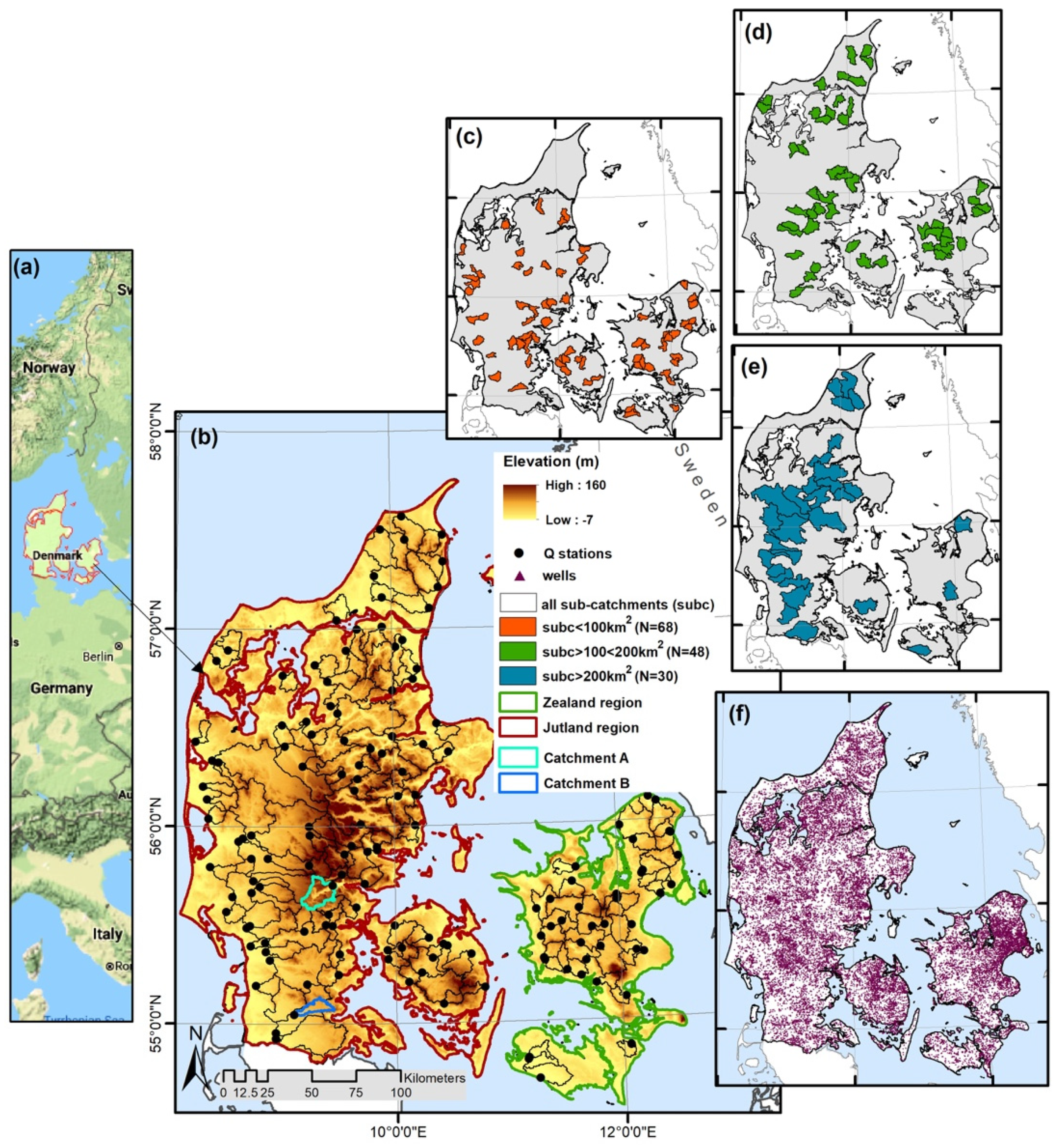
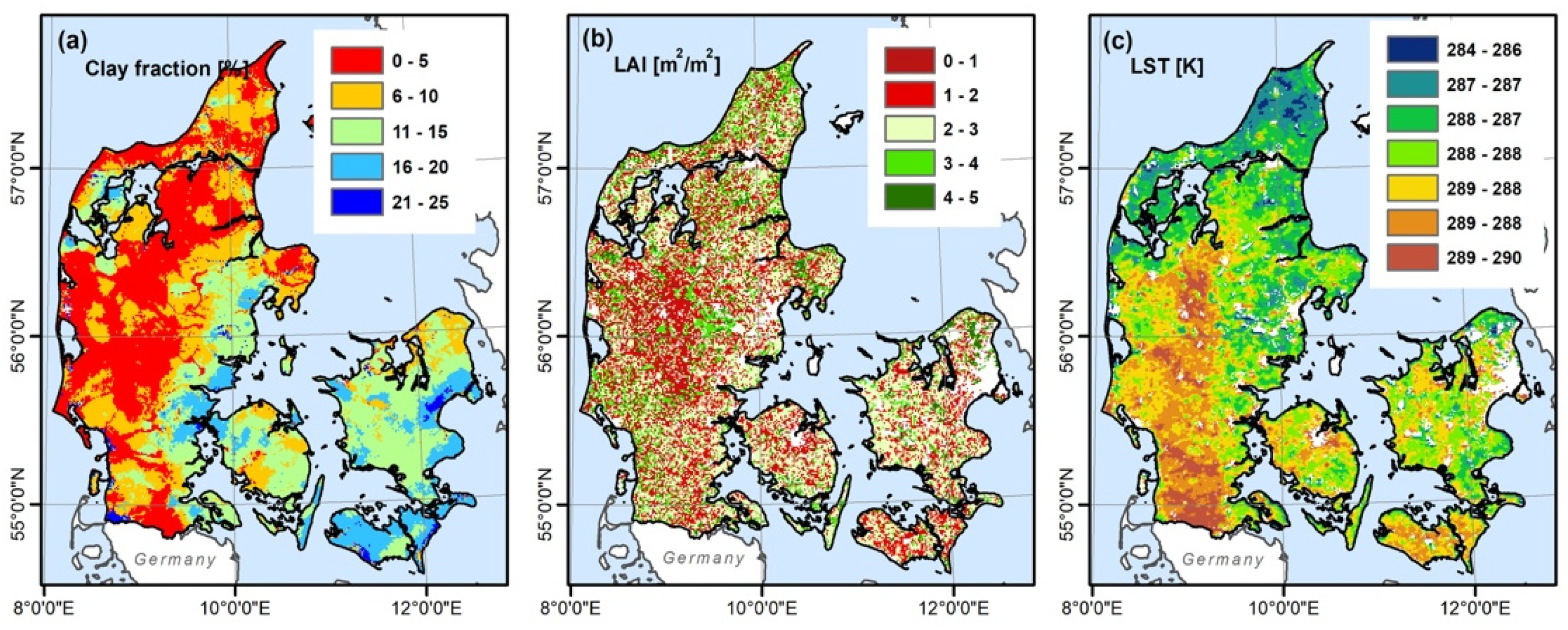
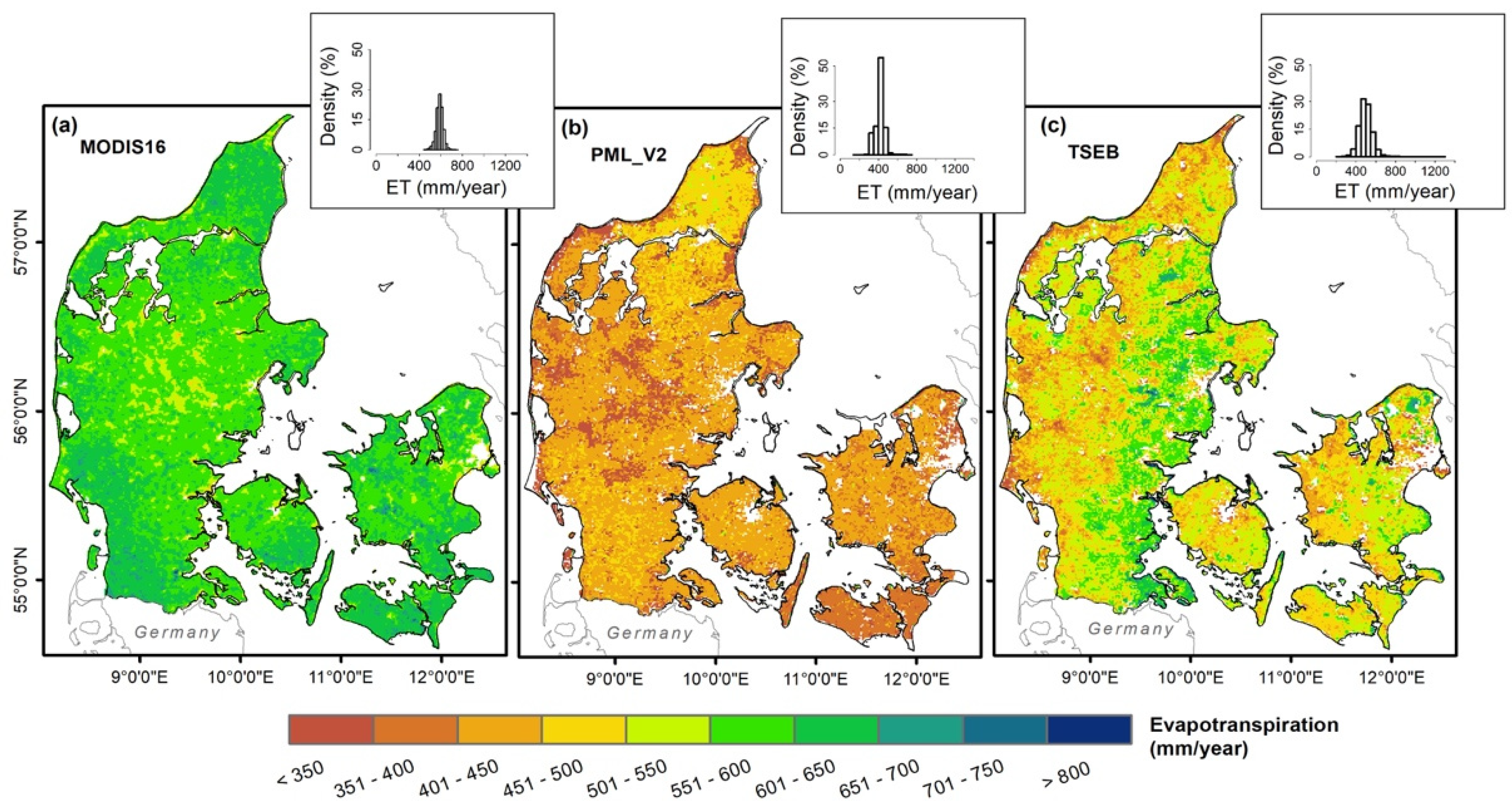
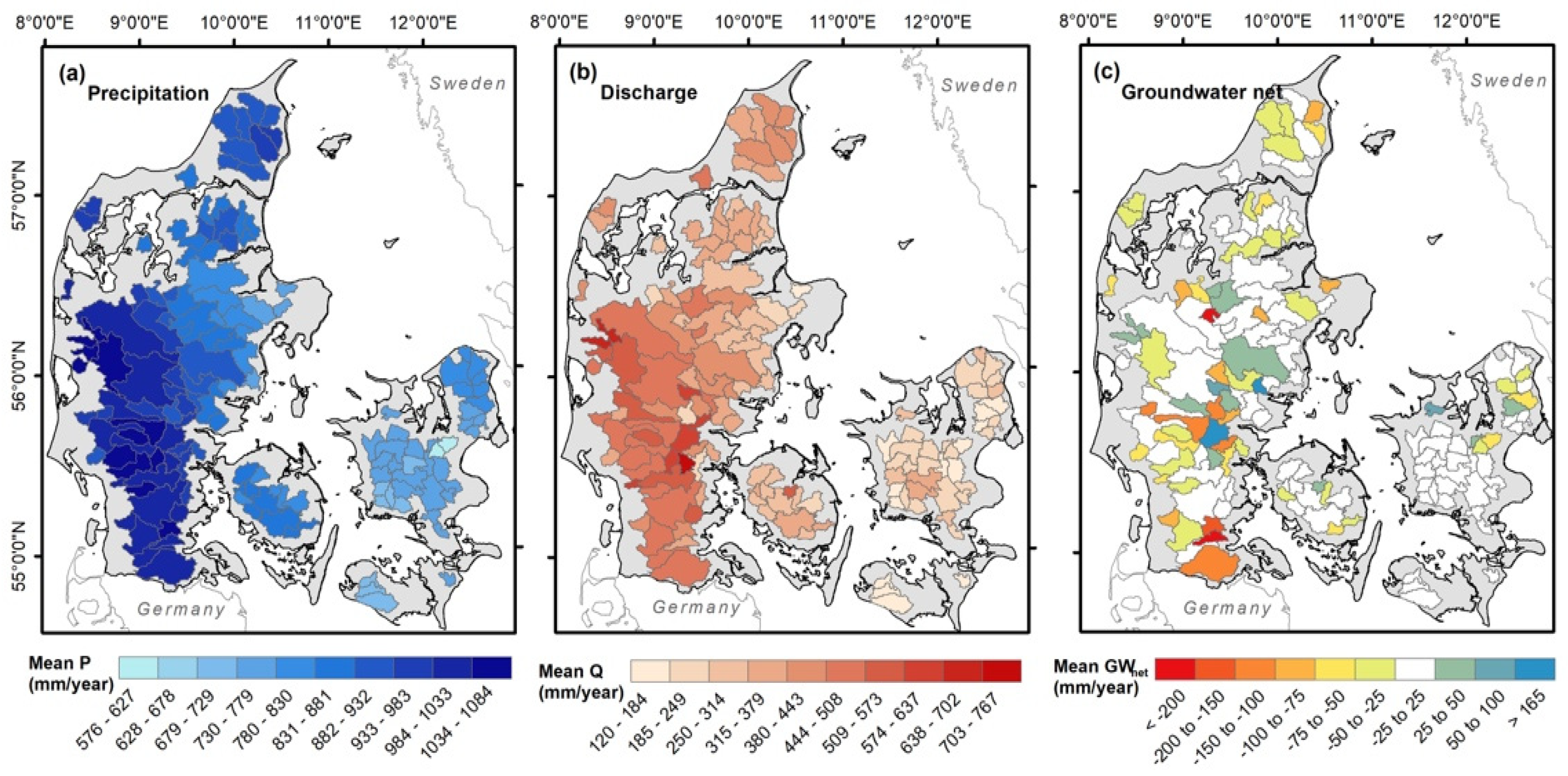

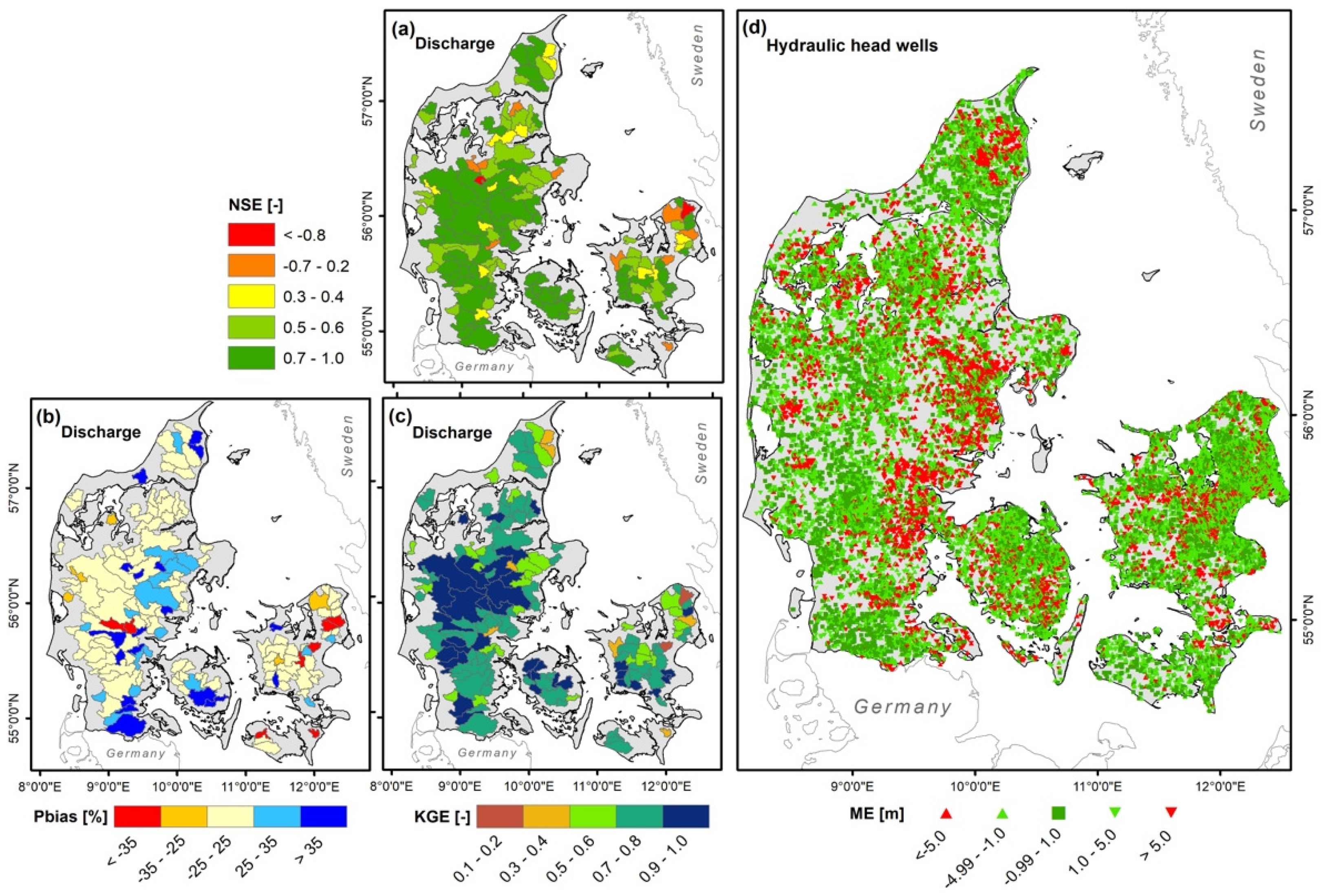
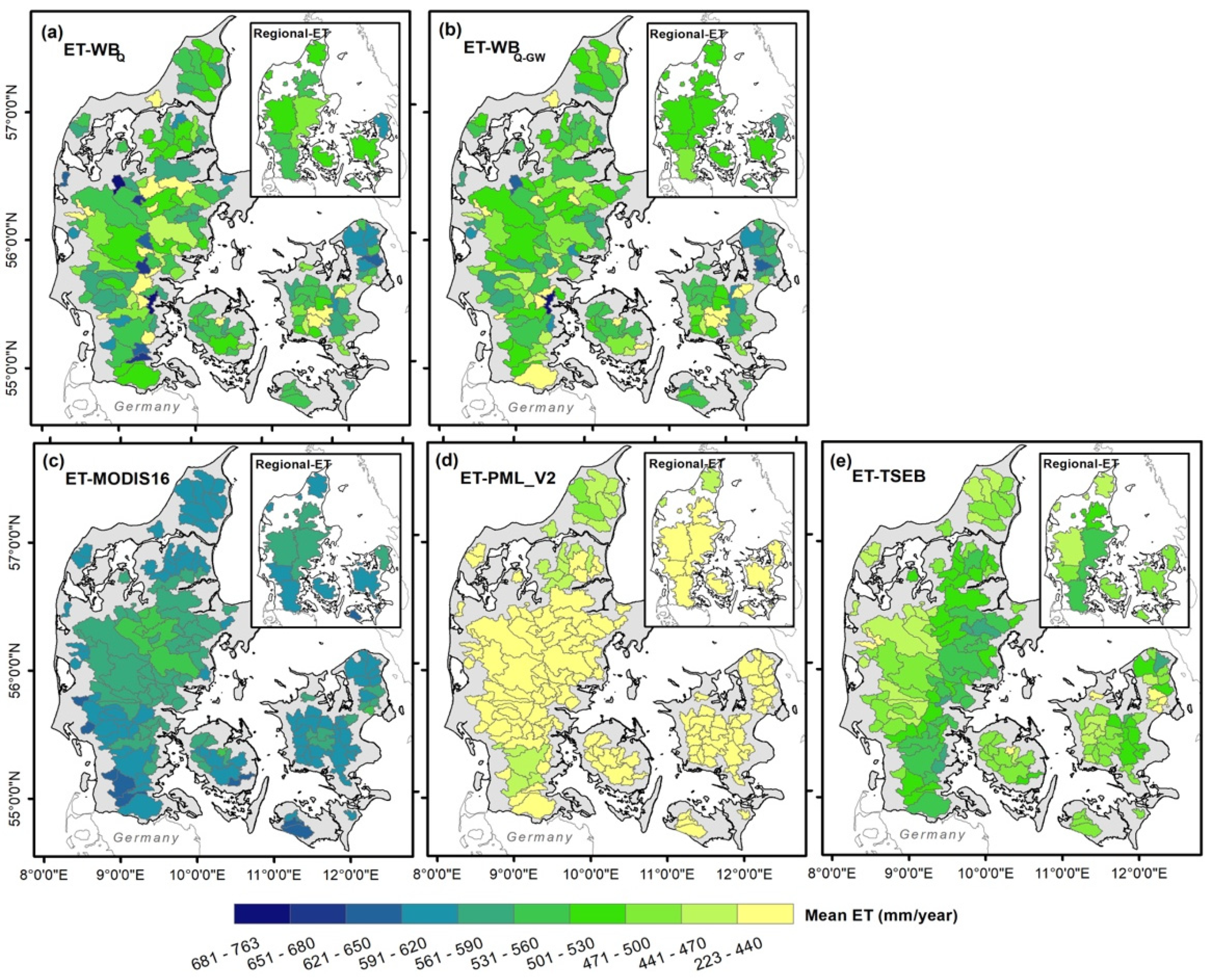
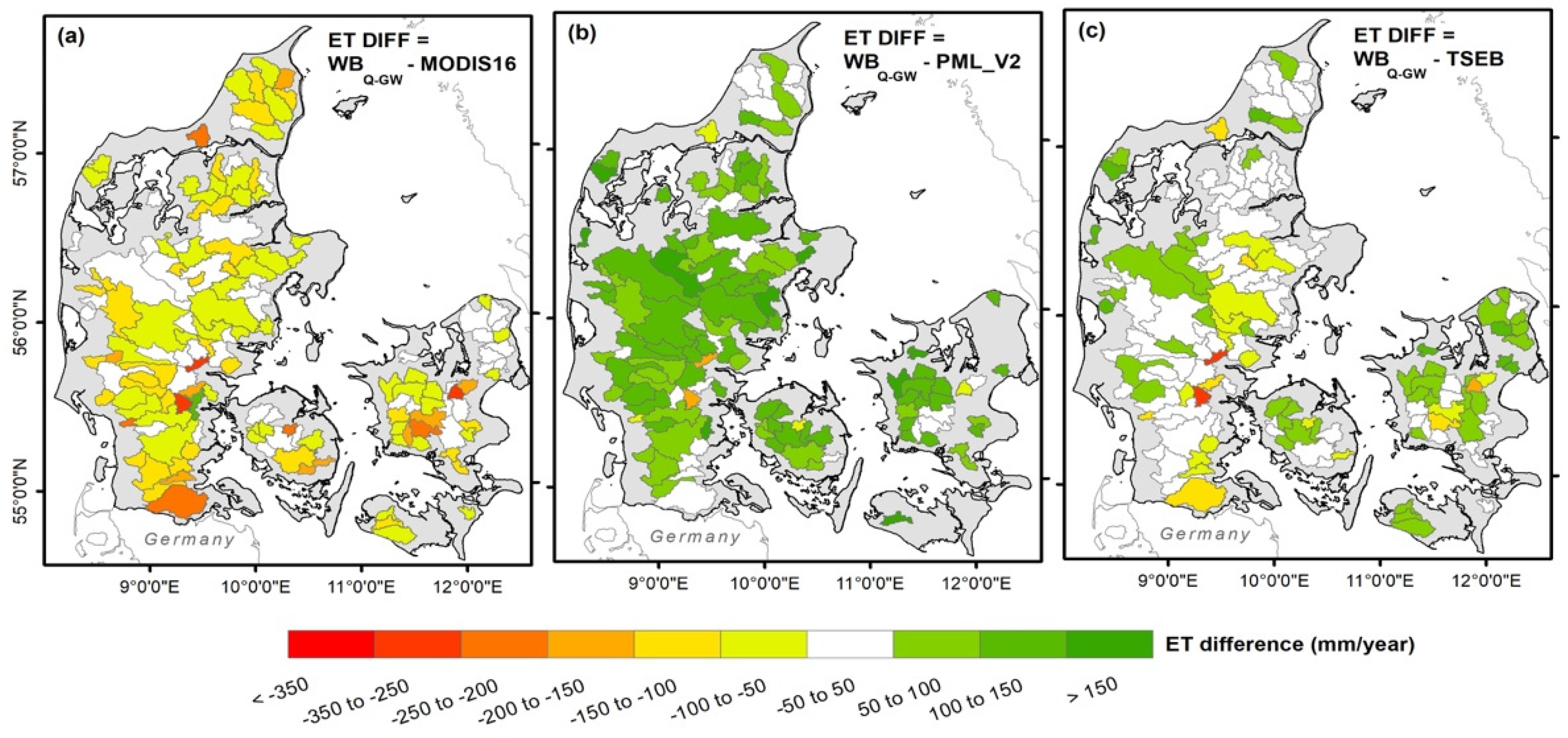

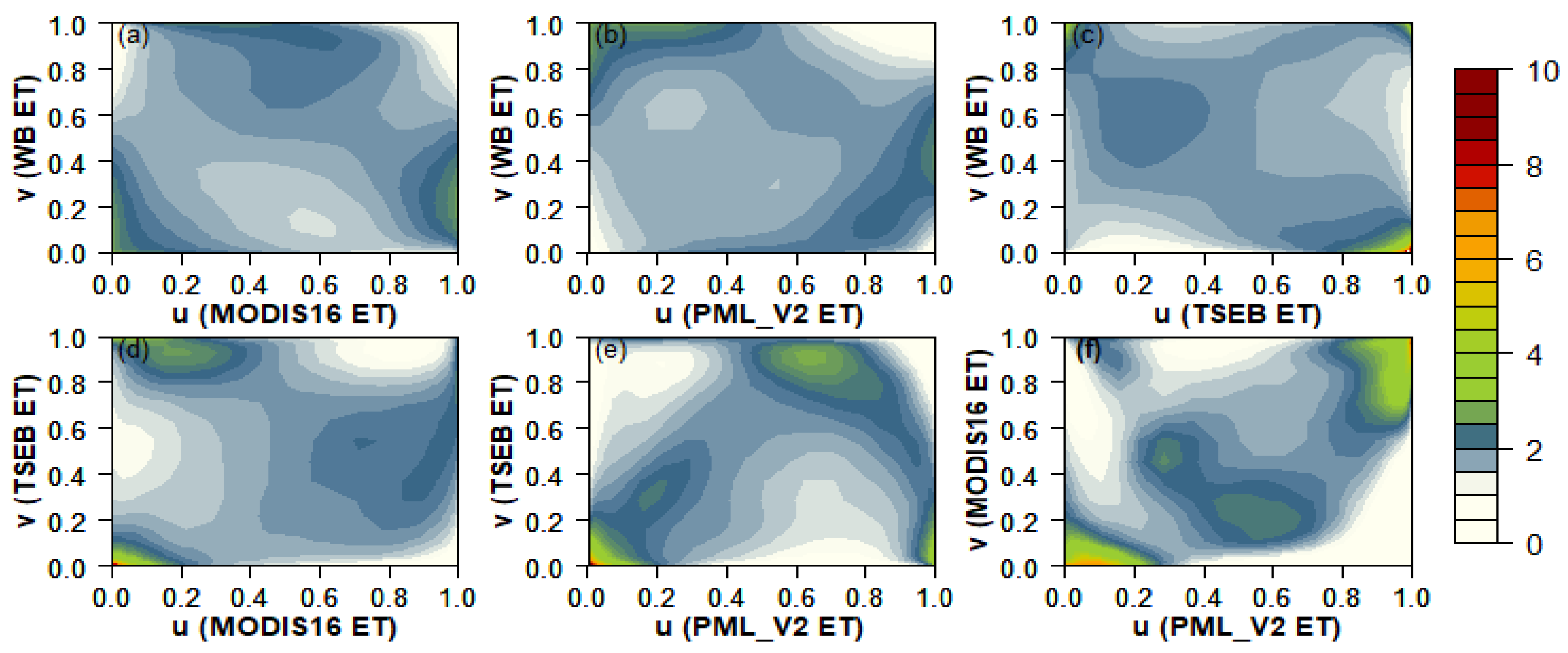
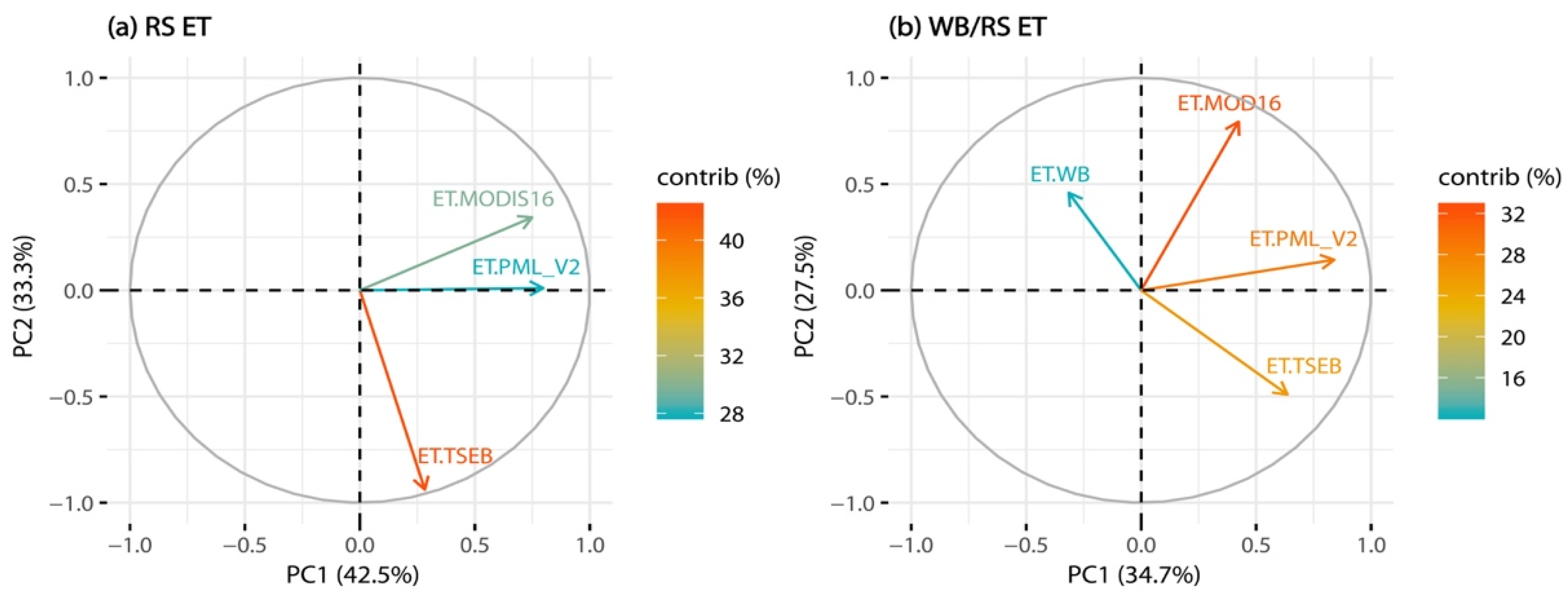
| Dataset | Algorithm | Spatial Resolution | Temporal Resolution | Input Data Source | References |
|---|---|---|---|---|---|
| MODIS16 | P-M equation | 1 km | 8-day | MODIS (land cover type2, FPAR/LAI, albedo) and flux towers/GMAO (forcing data) | [40,61] |
| PML_V2 | PML_V2 (ET and GPP coupled through surfaceconductance in P-M) | 500 m | 8-day | MODIS (LAI, albedo, emissivity) and GLDAS (forcing data) | [56] |
| TSEB | TSEB (based on P-T equation) | 1 km | daily | MODIS (LST, albedo, LAI) and ERA-Interim reanalysis (forcing data) | [14,57] |
Publisher’s Note: MDPI stays neutral with regard to jurisdictional claims in published maps and institutional affiliations. |
© 2021 by the authors. Licensee MDPI, Basel, Switzerland. This article is an open access article distributed under the terms and conditions of the Creative Commons Attribution (CC BY) license (http://creativecommons.org/licenses/by/4.0/).
Share and Cite
Soltani, M.; Koch, J.; Stisen, S. Using a Groundwater Adjusted Water Balance Approach and Copulas to Evaluate Spatial Patterns and Dependence Structures in Remote Sensing Derived Evapotranspiration Products. Remote Sens. 2021, 13, 853. https://doi.org/10.3390/rs13050853
Soltani M, Koch J, Stisen S. Using a Groundwater Adjusted Water Balance Approach and Copulas to Evaluate Spatial Patterns and Dependence Structures in Remote Sensing Derived Evapotranspiration Products. Remote Sensing. 2021; 13(5):853. https://doi.org/10.3390/rs13050853
Chicago/Turabian StyleSoltani, Mohsen, Julian Koch, and Simon Stisen. 2021. "Using a Groundwater Adjusted Water Balance Approach and Copulas to Evaluate Spatial Patterns and Dependence Structures in Remote Sensing Derived Evapotranspiration Products" Remote Sensing 13, no. 5: 853. https://doi.org/10.3390/rs13050853
APA StyleSoltani, M., Koch, J., & Stisen, S. (2021). Using a Groundwater Adjusted Water Balance Approach and Copulas to Evaluate Spatial Patterns and Dependence Structures in Remote Sensing Derived Evapotranspiration Products. Remote Sensing, 13(5), 853. https://doi.org/10.3390/rs13050853









